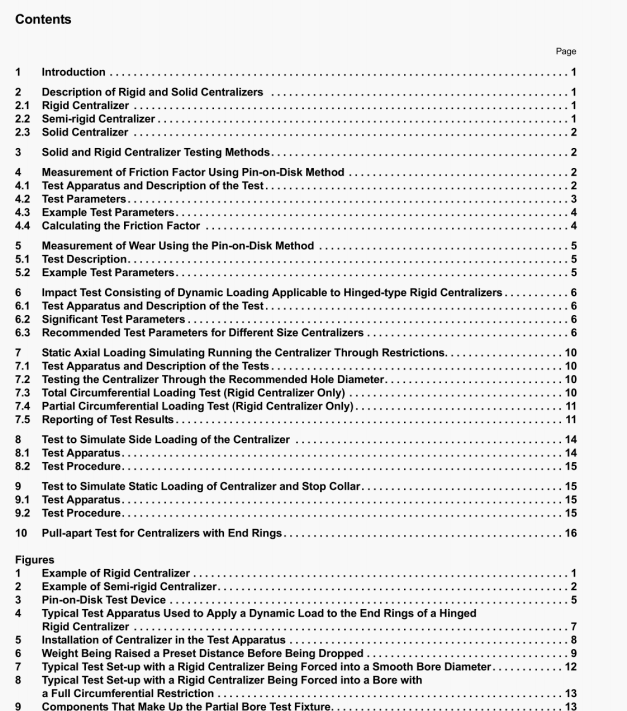API TR 10TR5:2008 pdf download.Methods for Testing of Solid and Rigid Centralizers.
6 Impact Test Consisting of Dynamic Loading Applicable to Hinged-type Rigid Centralizers
6.1 Test Apparatus and Description of the Test
This is considered a very severe test, and can be used to differentiate various desgns. The test device (see Figure 4) applies a predetermined dynamic load to the end rings of a hinged-type rigid centralizer, The upper-end ring retainer, or clamp, which supports the upper collar of the centralizer, Is part 01 the main structure. A second end ring retainer is located on the lower end of the traveling shaft used to apply the dynamic load. This lower clamp supports the lower collar of the centralizer being tested. The dynamic load is applied by dropping a traveling fixed weight a predetermined distance. The resulting load is absorbed by the two end collars of the centralizer being tested. The holding ability of the centralizer design under dynamic loading conditions can be determined using successive dynamic impacts.
6.2 SignifIcant Test Parameters
62.1 Size of the Pre-selected Dynamic Load
As the weight is increased, the dynamic load on ttie centralizer increases. A weignt of approximately 1,500 Ibm is
recommended.
6.2.2 Drop Distance for the Weight
The drop distance will also affect the results and should be consistent across all the comparison tests. A distance no greater than two (2) feet i recommended.
6.2.3 Number of Dynamic Impacts
The recommended maximum number of impacts is twenty (20). However in some cases, the user may apply repeated impacts to cause failure of the centralizer.
6.3 Recommended Test Parameters for Different Size Centralizers
7.1.1 Test Instrumentation
The instrumentation should be capable of accurately recording or otherwise indicating the apphcation of verlical loads, including the maximum load applied during the test. as well as the load at initiation of possible damage and/or failure of the centralizer, and if the safe limit of the testing device is reached (maximum allowed load level).
7.2 Testing the Centralizer Through the Recommended Hole Diameter
In this test the centralizer is run through the recommended (design) wellbore diameter to verify that the 00 of the
entire centralizer is as specified by the manufacturer.
The test assembly (see Figure 7) consists of an inner test casing (push mandrel) with an attached centralizer and a restriction sleeve (standard hole). The inner test casing should be similar to the inner test casing used to perform a starting or running force test as required by API Spec laD (ISO 10427-1). The inner test casing for the restriction tests described in this section must be sufficiently robust to withstand expected loads. The restriction sleeve should be within the tolerances indicated in ISO 11960 for non-upset pipe. Burrs or similar defects should be removed prior to testing. The restriction sleeve should provide a circular restriction through which the centralizer may pass. The upper edge of the restriction should have a 45-degree, beveled end, The restriction sleeve should also be of sufficient length to allow passage of the entire length of the centralizer through the restriction. The restriction sleeve should rest, vertically or horizontally, against a fixed surface.
API TR 10TR5:2008 pdf download
